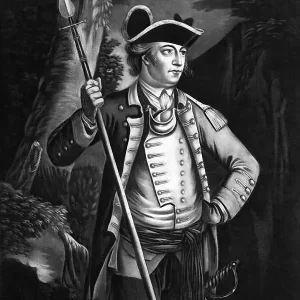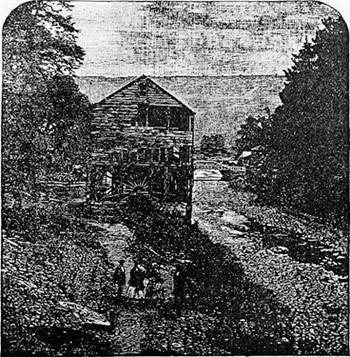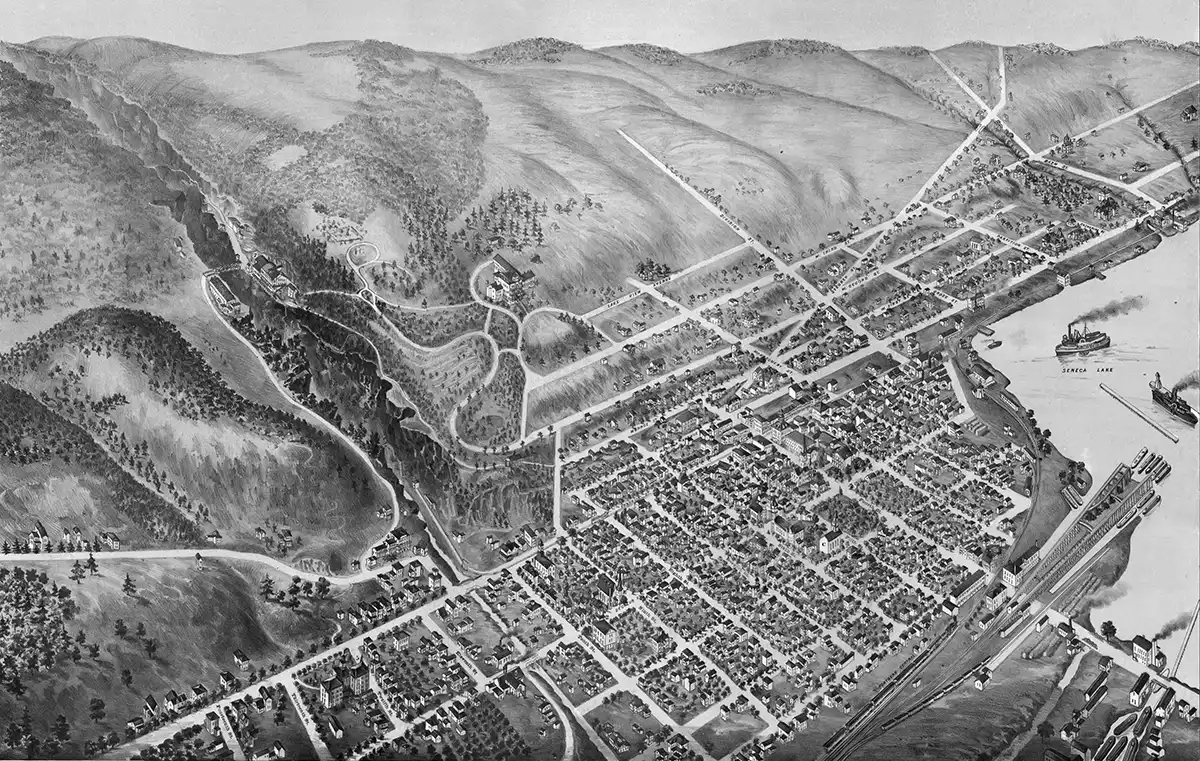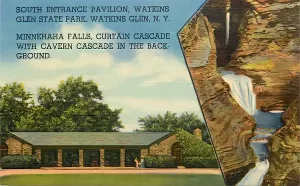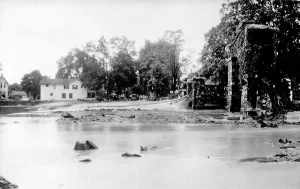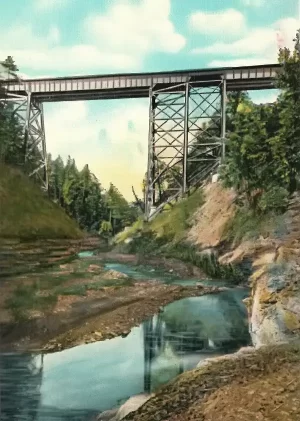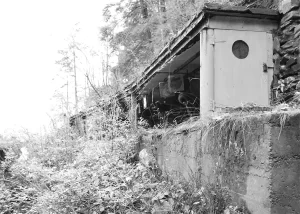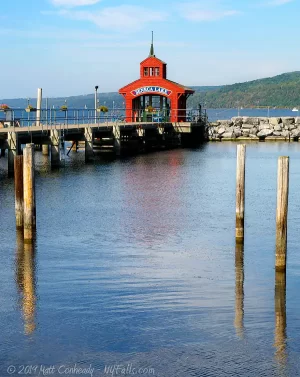1856 | – | Morvalden Ells ArrivesA newspaper editor from Elmira, Ells moves to the village of Watkins to purchase the local paper. He explored the glen, then privately owned, and wrote a descriptive article of its features. His wonder for the glen, knack for marketing, and the popularity of his descriptive article, inspired him to seek out a partnership with the landowner, George Freer, to open the glen to tourism. |
1858 | – |  Development of the Glen Development of the Glen
Ells hires workers to build wooden stairs, clear and expand paths within the glen, and build a gated entrance outside. |
1859 | – |  The Coal Industry The Coal Industry
John Magee founds the Fall Brook Coal Company, making coal distribution the village’s primary industry. Growth in Schuyler County increases rapidly. |
April 12, 1861 | – | The American Civil War Begins |
July 4, 1863 | – | 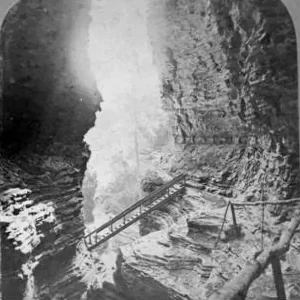 The Glen Opens The Glen Opens
Named Freer’s Glen: Mysterious Book of Nature, the glen opens for the first time, with only the Entrance Amphitheater to Cavern Cascade accessible. Upwards of 10,000 tickets sold in the first year. |
1864 | – | 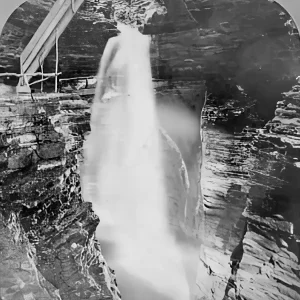 Freer’s Glen Opens for a Second Season Freer’s Glen Opens for a Second Season
Ells built a stairway (called Long Staircase) that led from Cavern Cascade to the top of the gorge (above Glen Obscura) to a wood refreshment facility called “The Glen Mountain House.” Ells concentrates on running the new establishment. In July, the trail to Glen Cathedral and to the Glen of Pools and Rainbow Falls is opened. |
1865 | – | 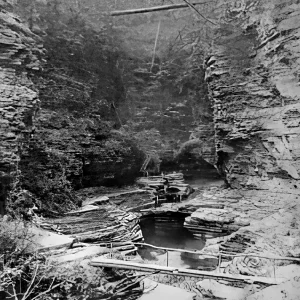 National Recognition National Recognition
Journal articles from around the United States begin publishing descriptions of the glen. Glen of PoolsThe section beyond Rainbow Falls is opened for the season. |
1868 | – | The Coal Industry DiminishesLess dependent on lake navigation and more on rail, Fall Brook Coal Company moves to Corning, NY. The village of Watkins becomes more dependent on tourism and agriculture. |
1869 | – | E.B. Parsons Buys Freer’s GlenFreer sells the glen to the entrepreneur from Troy, NY for $25,000. Parsons continues to develop the glen as a tourist attraction. Ells stays on as manager. During this era of ownership, the glen begins to be referred to (unofficially) as “Watkins Glen.” |
1870 | – |  The Swiss Chalet is Added The Swiss Chalet is Added
Parsons replaces the old Glen Mountain House, a small shack built above the glen with a two story resort, styled after a Swiss mountain house. “The Swiss Chalet” opens in May with a full kitchen, dining hall, parlor, and rooms for rent. James Hope Paints Rainbow FallsDownstate artist, James Hope, is commissioned to paint Rainbow Falls at Freer’s Glen. He explores the glen and falls in love with it. Watkins Sanitarium OpensThis grand resort atop the hills southwest of the lake opens to a boom of tourism. The resort is owned by George Freer. |
1872 | – | Mark Twain VisitsHe briefly describes the park in Chapter LXXVI of Roughing It: In one place in the island of Hawaii, we saw a laced and ruffled cataract of limpid water leaping from a sheer precipice fifteen hundred feet high; but that sort of scenery finds its stanchest ally in the arithmetic rather than in spectacular effect. If one desires to be so stirred by a poem of Nature wrought in the happily commingled graces of picturesque rocks, glimpsed distances, foliage, color, shifting lights and shadows, and failing water, that the tears almost come into his eyes so potent is the charm exerted, he need not go away from America to enjoy such an experience. The Rainbow Fall, in Watkins Glen (N.Y.), on the Erie railway, is an example. It would recede into pitiable insignificance if the callous tourist drew on arithmetic on it; but left to compete for the honors simply on scenic grace and beauty–the grand, the august and the sublime being barred the contest–it could challenge the old world and the new to produce its peer. |
1872 | – |  James Hope Moves Into Watkins Glen James Hope Moves Into Watkins Glen
He relocates from New York City to a new studio near the Swiss Chalet and devotes his time to painting the glen. Hope’s Art Gallery becomes a popular attraction at the glen. His son, J.D. Hope photographs the glen in stereoscopic 3D and sells prints to tourists. John J. Lytle Buys Watkins GlenE.B. Parsons sells the glen property to John Lytle, from Philadelphia, for $100,000 |
June 20, 1872 | – | Rock Fall FatalityWhile hiking up the Glen Cathedral section of the glen, a man and two women are hit by falling rock. One of the women is killed. |
1873 | – | 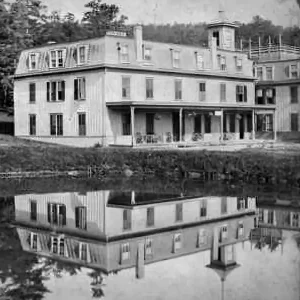 The Grand Glen Mountain House Opens The Grand Glen Mountain House Opens
Lytle builds a large resort atop Glen Obscura across the glen from the Swiss Chalet. The Swiss Chalet is completely converted to a dining facility. The new Mountain House is beautifully landscaped and capable of housing 300 guests. A suspension bridge was built linking the two sides of the glen. Havana Glen OpensAs a competing attraction, Havana Glen opens to tourists south of Watkins Glen in Montour. |
1874 | – | St. Mary’s Cemetery OpensAdjacent to existing Glenwood Cemetery, this property caters to the Catholic population of the village. |
September, 1874 | – | P.T. Barnum’s Grand Traveling World’s Fair Performs“The Greatest Show on Earth” is put on in the village of Watkins. |
1877 | – | 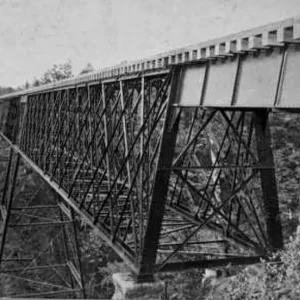 The Fall Brook Train Trestle Is Built The Fall Brook Train Trestle Is Built
The Fall Brook Railway is constructed, and it passes over the Glen. Primarily to ship coal, the railway helps to eliminate Watkins Glen as a hub for barge shipping on Seneca Lake and the Chemung Canal. |
1878 | – | The Chemung Canal ClosesMade obsolete by the rail industry. Canal properties and parts were sold off at auction in subsequent years. |
1880s-1890s | – | Seneca disappear from Watkins GlenFrom the Sullivan Campaign, commercial development, racism, and assigned reservations, the Seneca no longer inhabit the Watkins Glen area. |
*Date Unknown* | – | 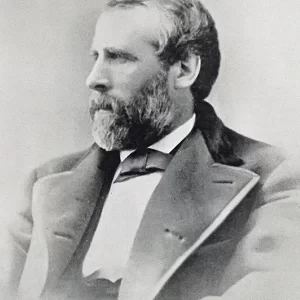 Andrew Haswell Green Buys Watkins Glen Andrew Haswell Green Buys Watkins Glen
Famed conservationist, lawyer and NYC urban planner, Andre H. Green acquires the glen for $100,000. In this era, the attraction becomes known as Watkin’s Glen. |
1882 | – | Salt FoundWhile drilling for petroleum, the Watkins Oil Company finds salt deposits. The Salt industry booms through the 1900s and still exists to this day. |
1885 | – | Adirondack and Catskill Parks are EstablishedNew York State designates these lands as protected and to never be sold. |
1890 | – | 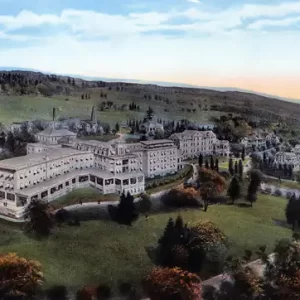 The Glen Springs Sanitarium The Glen Springs Sanitarium
Formerly the Watkins Sanitarium, this resort, greatly developed, sees a boom in business as mineral baths become popular for people suffering from a variety of ailments. |
October 20, 1892 | – |  Artist J.D. Hope Dies Artist J.D. Hope Dies
His family continues to operate his gallery. |
1899 | – | The New York CentralThe Fall Brook Railway is incorporated into the New York Central network of rail. |










